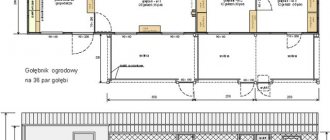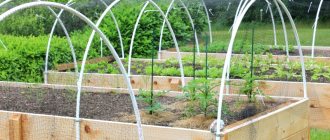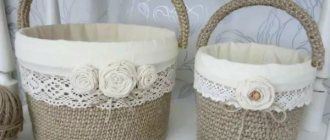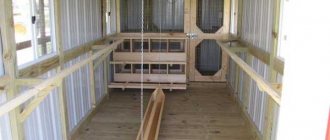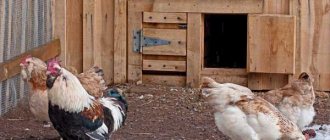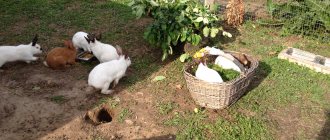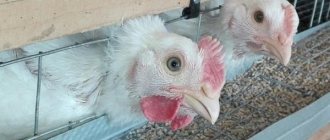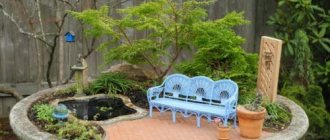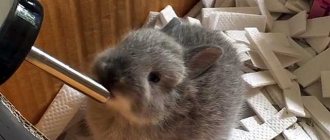Briefly about the main thing
As a rule, geese begin to lay eggs in the spring: in late March - early April. But if the barn where the geese are kept is warm and humid enough, and the females’ diet is dominated by protein foods and mineral supplements, then they begin to lay eggs as early as February.
What else affects the level of egg production, read the article “How many eggs do geese lay?”
Already at the beginning of the year, you need to make sure that each hen has her own nest. This is ideal, but it often happens that 2-3 geese take a fancy to one nest and lay eggs in it at the same time. In these cases, each masonry is marked with different symbols so as not to be confused.
Wicker nest type
Having a small farm outside the city, when the number of geese in the flock is not too large, you can make wicker nests. These types of baskets appeal to hens for several reasons:
- warm natural raw materials;
- convenient rounded shape, similar to nests in wild natural conditions;
- simple design that is easy to ventilate.
Required materials and tools:
- fresh willow wood rods of different sizes (thick for making the base, narrow for the sides);
- metal spacer ring measuring 75 cm in diameter;
- auxiliary tools: knife and awl.
Types of goose nests
It is recommended to make goose nests of different types so that each goose can choose the right one. To do this, you can use items found around the farm, for example, thick boxes, old fruit baskets, car tires, or large buckets turned on their sides and mounted on a flat base.
Any of these structures should be disinfected before use, covered with bedding material and, if necessary, equipped with a bridge for birds to climb onto.
You cannot use a metal base for the nest, as hens often bury their eggs under the litter. Contact with cold metal can cause the shell to crack and the embryos to freeze.
Nesting box in the form of a wooden box
Neat rectangular sectional spaces, including several drawers, fill the minimal area of the utility room. These types of nests are convenient on large farms, where the number of geese reaches several hundred. Creating this type of nest does not require much effort, and it will not take much time. Materials and means used for manufacturing:
- wooden lining, planks, OSB (non-new raw materials are also considered suitable for use, provided there is no mold or dust);
- plywood or solid board to create the bottom;
- bars for making supports in the amount of 4 pieces, measuring 5-6 cm in diameter;
- fasteners in the form of nails, screws and other products;
- tools such as hammer, saw, measuring tape.
Other options
Nests made from construction mesh are popular abroad. A pipe of the required size is formed from it, secured with clamps and tightly wrapped in straw, securing it with a second layer of mesh. The protruding metal edges are cut off, and the nest-pipe itself is strengthened on a stable wooden base.
Even old cabinet furniture, such as an armchair or desk, can be used as nests by removing excess partitions or adding them in the right place. In this way, you can place several hens at once. Read more about how to make nest sections below.
How to build a gooseneck
Poultry breeding has been a long-standing occupation of people permanently living in rural areas. One of the popular areas of poultry farming is keeping domestic geese. This is a strong and beautiful bird, the meat of which is very healthy and tasty. She lays large eggs that have a wonderful taste. Goose down is the best filler for feather beds and pillows.
Feeding geese to market size does not present any particular difficulties or significant costs - they receive most of their nutrition from pasture. You just need to organize grazing correctly. Ideally, there should be a river near the breeding site. The goose is an intelligent bird and always returns home after a walk, where it is prepared for additional feeding and comfortable living.
The gray goose is the most effective breed for stripping at home
Gooseneck device
Before you start building a barn for keeping geese, you need to decide on the design, taking into account the following circumstances:
- the absence of drafts is one of the main requirements for the premises;
- comfortable temperature and dryness. For geese with thick skin and a layer of subcutaneous fat (with proper feeding and maintenance), temperatures down to zero degrees are not terrible, but the best conditions are 22–28 degrees;
- good air circulation in the room, which is usually organized in the form of ridge or box ventilation using a deflector.
If such conditions are not met, one should expect a decrease in egg production, reproducibility of the herd and a deterioration in the taste of goose meat.
The standard of use for the area of the premises must be at least one square meter for each individual, that is, for 10 geese you need a room of 10 square meters, and for a hundred - 100. The external areas of the goose barn must be equipped with canopies from the sun or bad weather. Compliance with the required area will save the poultry house from excessive pollution, and the birds from diseases and uncomfortable living.
Poultry houses and outdoor areas should be divided into sections with a capacity of up to 50 birds. Birds of different breeds are also kept separately. The room should be delimited into sections by removable mesh partitions up to 120 centimeters high.
Video: portable enclosure for young animals
If there is no natural body of water nearby, you need to place containers of water near the place where the geese are kept or dig a pond. For ease of use, it is better to cover the bottom and sides of the dug container with plastic film. During use, you need to monitor the condition of the water and refresh it in time. If complete or partial replacement is necessary, water from the pond can be used to water garden plants.
The goose receives its main nutrition in the form of pasture
The birdbath should be designed as a trough and preferably have running water. To flush the gutter, you can arrange a drain from a plastic pipe of the appropriate size cut lengthwise. The norm for using a drinking bowl is calculated from a minimum length of six centimeters per individual.
Differences between goose and chicken nests
Unlike nests for chickens, which require a small elevation for the bird to take off and can even be located multi-story, goose nests are placed at floor level. There are often cases when a goose, unable to climb into a high nesting box, lays eggs on the cold ground or concrete floor. And the cold, as we said above, is destructive for future goslings.
In a chicken coop there are usually 3-5 hens per nest, while geese require more space and privacy.
Goose nests are made larger than chicken nests, depending on the size of the bird. They should be secluded enough to retain heat, and spacious enough so that the goose can stay in it around the clock without embarrassment.
Some useful tips
To ensure that the breeding of the young goes without problems, and the goose does not abandon her offspring, it is recommended to adhere to the following rules:
- the geese should be as far as possible from the nests so that the geese do not become nervous;
- each female must be in her own nest;
- To stimulate egg production, you can use white dummies that resemble eggs and place them under the goose.
Thanks to the correct arrangement of nesting houses, a high percentage of egg production in females is ensured, which contributes to the hatching of goslings in sufficient numbers.
We invite you to join our Zen channel and group on VKontakte or Odnoklassniki, where new articles are published, as well as news for gardeners and livestock breeders.
Similar articles:
- Technology for producing goose down
- Choosing a diet for geese before the start of the reproductive period
- Where to keep geese during the cold season?
Suitable sizes
Standard dimensions of a nest for laying eggs: width - 60 centimeters, length -70 centimeters, height - 60 centimeters. To incubate the eggs, the nesting box is made a little deeper.
Some farmers, in order to take care of their hens, make the nest box very spacious, 100 by 100 centimeters. But whether this option is right for you depends on the amount of suitable space in the house and the preferences of the geese themselves.
In general, the size of nests for geese is adjusted in accordance with the dimensions of a particular breed. You will find information on the topic in the article “Description of breeds of geese.”
Variety of nesting designs
There are a number of options for nesting houses for geese. Each farmer chooses the type that is needed in a particular farm. Much may depend on the availability of free space in the room, the necessary materials, the number of livestock, etc.
The most common types are the following:
- round designs. To make them, an ordinary large basket or tire from a vehicle is suitable;
- structures equipped with a wooden bottom and walls. The house is also covered with slate sheets;
- use of construction mesh. It is rolled up like a pipe and secured with clamps. Such a nest is attached to a wooden base and lined with soft bedding materials;
- separate wooden houses with a common entrance, but separated from each other by blank partitions. These designs are most often used on farms where large numbers of poultry are kept.
DIY sectional nests
Preparing the tools
For a large flock, the ideal option would be to build a sectional nest for geese with your own hands. As a base you can take, for example, plywood, OSB or chipboard. It is convenient to make such sections in 3-4 pieces on a common basis; they are compact and quite simple to manufacture.
To build a sectional nesting box you will need:
- any particle boards, plywood or lining;
- support bars 5 centimeters thick;
- nails or screws (the latter option is preferable - it will increase the shelf life of the socket);
- saw;
- roulette;
- drawing with dimensions;
- hammer or screwdriver.
Step-by-step assembly instructions
Wood scraps and materials do not have to be new, but clean and dry, free of mold.
Step-by-step procedure for making a sectional goose nest:
Cut the planks into pieces of the same size (the optimal dimensions of the nest are indicated above). These will be the side walls and internal partitions. For the roof and rear wall, dimensions are calculated based on the number of sections and the selected dimensions of each compartment.
Nail the planks to the four support rails at small intervals.
The front part remains open and is equipped with a protective threshold 10 centimeters wide. This will prevent eggs and straw from spilling out.
If the floor of the poultry house is insulated with foam plastic, then the box can be placed without a bottom. If the floor is concrete, it is worth making the bottom from the same material as the side walls.
The partitions between the sections are made high enough so that the hens do not disturb each other.
During incubation, the hole is covered with cloth or a thin straw mat, so that it is convenient for the goose to enter and exit the nest.
We build a nest for laying eggs
Making a nest is not difficult, and you can always use materials available on the farm. It is not recommended to make nests from metal, since laying hens sometimes hide their eggs under straw and when they come into contact with a cold surface, especially in winter, they break or freeze. We will need environmentally friendly material: in the first option, wooden lining, in the second, willow twigs.
Design dimensions.
| Number of eggs hatched | |||||
| Bird species | chicken | turkey | goose | duck | Nest dimensions (width, length, height, cm) |
| Chicken | 11-13 | 17-19 | 3-5 | 7-9 | 40x30x40 |
| Turkey | 17-19 | 15-17 | 9-11 | 15-17 | 60x60x70 |
| Duck | — | — | — | 11-13 | 40x50x50 |
| Goose | — | — | 9-11 | — | 60x75x60 |
Option one: nest in the shape of a wooden box
Compact rectangular sections with several nest boxes, occupying a minimum of poultry house space, are indispensable in large farms where the flock of geese numbers several hundred heads. Making such a nest does not take much time and effort.
Tools and materials:
- planks, lining, OSB - everything that was found on the farm. You can use wood that is not new, the main thing is that it is free of mold and rot;
- bars for support - 4 pieces, 5-6 cm in diameter;
- fasteners (screws, nails, etc.);
- tools: hammer, tape measure, saw;
- plywood or board for the bottom (if desired, install it).
Detailed instructions
Step 1. Prepare the slats. It is necessary to cut the planks or lining into identical fragments. For the side walls, the length of the slats will be 60-70 cm. Two of these need to be prepared. You will also need two end blanks 50 cm long, in one of them you need to make a hole for the goose.
Preparing the support rails
Step 2. We sheathe the frame. Planks are nailed to the four supporting bars at small intervals. The gap can be 5-6 cm, the main thing is that the goose’s head does not fit into it.
Making markings on an OSB sheet
Using the markings, we outline lines for cutting the material
OSB cutting
Step 3. Decorate the front wall. The three walls should be identical in appearance, and a free entrance should be left on the front, limiting it with a pair of slats on top and a small (10 cm) threshold on the bottom so that eggs do not roll out and straw does not fall out.
Step 4. Nail the bottom. You can install the box directly on a foam-insulated floor. On a bare concrete base, it is better to make the bottom from wooden boards or plywood.
We screw the pre-prepared bars to the edges of the planks and assemble the nests
Fixing all elements with self-tapping screws
We fix the roof
We fasten the end strips
Step 5. Protect the wood. To extend its service life, the wood is treated with protective agents. Choose products that are not toxic to birds.
Three nests for geese
Step 6. We build a bridge. To make it easy for the clumsy goose to climb, you need to build a wooden bridge across the width of the nest. The ladder is attached to the threshold.
The nest is ready. Make them in the required quantity and place them away from drafts in a semi-dark part of the house, without leaning tightly against cold walls. Most often, nests are located on the side walls of the poultry house.
Prices for OSB (oriented strand boards)
OSB (oriented strand board)
Option two: wicker nest
At a dacha, in a small household plot, the flock of geese is usually not numerous; for several geese you can make a wicker nest. Geese really like these baskets: warm natural material, familiar round shape, like in the wild, lightweight design, well ventilated.
Tools and materials:
- fresh willow twigs of various thicknesses and lengths (thick ones are needed for the base, thin ones for the sides);
- metal spacer ring (diameter – 75 cm);
- tools - knife, awl.
Willow twigs
Step-by-step instruction
Step 1. Material for the base. First, a cross is woven, which gradually takes the shape of a circle. Prepare an odd number of rods. One of them will be shorter than all the others.
Step 2. Formation of the frame. Three rods are cut in the center and 3 more rods are inserted into the resulting hole. The seventh rod is attached to the side of the cross. All rays are aligned. On the other side, a braiding rod is placed into the cut.
Step 3. Making the bottom. The crosspiece is braided in a criss-cross manner. The coils are applied closely, and the ends are hidden next to the rib. The base is woven until it reaches the desired size of the nest. In our version, the bottom radius is 35 cm.
Step 4. Making the side of the nest. Round and large rods are selected for the side frame. The end of each rod is sharpened with a knife. The selected base will require 29 guide beams, which are located at the same distance from each other.
Step 5. Edge processing. The edge of the nest is braided. You can take material of different shades, then the drawing will turn out more interesting. All ends of the braided rods are brought out so that they can later be cut off.
Weaving a nest for a goose with your own hands (part 1)
Step 6: Insert spacer ring. The beams are bent, the ends of all the side rods are collected into one bundle and secured with wire. A ring is placed inside the structure, fixing it on the sides.
Step 7. Edge decoration. Now you can release the tied rays in order to braid the edges of the basket with these ends. They wrap one edge around another, bend 5 cm near the adjacent one and trim the tip. All that remains is to tuck the end in. Braid the last rod and trim off all protruding ends.
Weaving a nest for a goose with your own hands (part 2)
Basket options are selected according to your needs: you can weave a tall one, in the shape of a cylinder with an inlet hole, or a wide, open one, in the shape of a hemisphere.
Another option for a wicker nest
DIY wicker nest
Required Items
Another DIY goose nest option is a round wicker basket made from willow vine. This variation is suitable for small households where there are few hens. Geese really like such nesting boxes; they are well ventilated and keep warm.
To accustom a goose to such a place, usually no additional tricks are required, because the basket imitates the nest that the bird builds in the wild. However, in this case, the partition separating the hens will have to be taken care of separately.
To make a willow nest you will need:
- fresh willow vine - thin and thick twigs;
- a metal ring with a diameter of 75 centimeters (can be made from thick wire);
- awl and knife.
Step-by-step assembly instructions
First, a cross-base is made, giving it a round shape.
Thick rods are sharpened with a knife to 3 centimeters and inserted into the base at an equal distance in an odd number; these will be the side stiffeners. They continue to be braided in a circle.
The round base is woven up to a diameter of 70 centimeters. Then the thick beam rods are bent upward. At a height of 20 centimeters from the base, a metal ring is fixed inside so that it clearly holds the shape of the future basket. The rays are tied at the top in the center into a bun, for convenience during weaving.
Continue weaving the sides in the same way. Having reached the level of the ring, the rods are untied and cut, leaving 7-8 centimeters in length.
Now they braid the edge. To do this, take one of the cut rods, bend it around the adjacent one and, next to the third, insert it vertically inside the sidewall, threading it into the weave and cutting off the protruding piece. Then do the same in a circle with each rod.
Production rules
Building nests for geese with your own hands is not particularly difficult. Moreover, there is always the opportunity to use the household resources at hand. Making nests should not be done using metal materials, because hens often hide eggs under the flooring, and if they come into contact with the cold bottom of the structure, especially during the cold season, they can freeze or break.
In order to properly make a cozy nest, in which it will be convenient for females to lay eggs and hatch their offspring, you will need natural raw materials. In this case, two types of materials are used:
- wooden lining;
- willow twigs.
Design parameters: 60x75x60 cm (width, length, height).
Preparation for use
Disinfection and bedding material
Before use, the nest must be treated with a disinfectant solution. It can be prepared from caustic soda (2%), formalin (1%) or bleach (2%). Or buy a ready-made substance that is safe for animals. For example, “Virocide” or “Ecocide”.
The bottom of the goose nest is covered with dry soil, sawdust, peat, crushed corn cobs, sand, millet and seed husks. To prevent the appearance of parasites, add a little ash mixed with crushed wormwood herb down. The top is covered with straw - hay is not suitable as bedding.
To prevent the eggs from rolling out in the corners, several small depressions are made in the middle of the litter, sufficient to accommodate the entire clutch without the eggs clumping together.
One bird per year requires about 35 kilograms of bedding material, so it is worth taking care of it in advance, as well as the conditions for its storage. Straw, grass, etc. should be stored on wooden pallets in a well-ventilated area. Regular turning will save the bedding material from dampness and mold.
Additional terms
Geese lay eggs in the morning, once every two days, so the bedding is replaced in the evening so that it is clean all the time and does not become damp or moldy. An excellent help in keeping bedding material dry is fluff lime, which is used to treat wet areas of the poultry house when dampness appears.
It is not recommended to cover the nest with solid material such as felt, since excess moisture and dirt should pass freely through the litter.
In addition to droppings, the shell can become dirty with protein from eggs that the hen breaks if the embryo in them is frozen. Clogged pores in the shell prevent normal air exchange and reduce the chances of the chicks hatching successfully.
Eggs stained with droppings can be cleaned 2 hours after laying, and while the hen is not near the nest. To do this, use a slightly colored solution of manganese or hydrogen peroxide. To avoid damaging the eggshell, use a soft cloth when cleaning. All movements must be careful - you cannot press on the shell.
How to properly arrange a goose's nest
Before laying eggs, crushed material similar to bedding is poured into the bottom of the nests: chopped corn cobs, straw, peat, sand, sunflower or millet husks. To prevent parasites, add a little ash to the bottom. Then the female will cover everything with her down. Females lay eggs in the first half of the day, every other day. Therefore, it is better to update the litter in the evening so that it is always dry, clean, hygroscopic, without traces of mold, since its quality affects the health of the geese. In a damp nest, the female's feathers are dirty, do not retain heat, and the laying hen's immunity drops. At the first sign of dampness, it is neutralized with fluff lime. Up to 40 kg of litter is required for 1 head per year, so it is important to prepare the material in advance.
It is important to update the litter on time
Geese tolerate freezing temperatures well, but if the nest is 4 degrees below zero or below, the eggs freeze and the chicks will not hatch during incubation. That’s why it’s so important to equip high-quality, insulated nests in unheated rooms in winter.
Until daylight hours approach 14 hours, to increase egg production, you need to turn on the electricity from 6 to 20 hours.
It is important to keep ganders away from brood hens. It should also be monitored to ensure that birds do not fight or confuse their nests.
If a goose is used repeatedly to hatch eggs, it is strictly not recommended to transplant it to another nest. This will be seriously stressful for her. To ensure that a caring mother does not refuse to hatch her offspring, place someone else's fresh (no more than 10 days old) eggs in her usual environment.
The goose will quickly get used to its new house if it lays its first egg in it. Confirmation that she has chosen him may be the fluff that the female plucks out while covering the selected nest.
The goose puts its down in the nest
To awaken the brooding reflex, farmers place special dummies in the nests.
Creating general comfortable conditions for geese will help consolidate the result: birds do not tolerate stuffiness and high humidity. The length of daylight hours should also be adjusted using additional lighting.
Lamp for additional lighting
Arrangement of the nest
Selecting a location
Whatever design you choose, it should be installed away from cold walls and drafts, in a corner with moderate lighting, preferably on the south side of the house. In this case, the nest should be open for viewing, ventilation, changing bedding and collecting eggs.
Particular attention should be paid to ventilation, since embryos need fresh air for good development. And the geese themselves do not tolerate stuffiness well.
Temperature
Goose fat protects birds' bodies well from the cold, allowing them to withstand temperatures below zero. However, the embryos of future goslings die at -4 degrees. Therefore, in winter, if the poultry house is not heated, sections with nests are properly insulated with straw, polystyrene foam, and natural fabric: cotton, linen.
If the room temperature is below zero, laid eggs should not be left in the nest. They are taken out twice a day (in the morning and evening), while still warm. After which it is cooled to a temperature of 12-18 degrees and then stored in a dry and clean container, free of foreign odors and mold.
It is impossible to completely remove the clutch - in order for the goose to continue to lay eggs, real eggs are replaced with dummies.
Lighting and diet
Daylight hours during laying should last 14 hours. During the dark seasons it is supported by electric lighting from 6am to 8pm.
During the period of laying eggs, the goose must be fed properly. The physical condition of the female and future offspring, as well as the proper formation of eggs, depend on the diet. The menu for laying hens consists of protein, mineral and vitamin supplements, and feed fats.
What should be included in the diet of geese during laying is described in the article “What to feed geese from the first days of life at home.”
Climate and lighting
Regardless of the materials used in construction, certain humidity and temperature parameters must be observed in the lining barn.
The health and productivity of geese depends on the microclimate in the poultry house.
- For geese, the optimal temperature for living is considered to be 10-30˚C. In the goose barn, the air temperature should be within 20˚C. Extreme heat or cold can lead to reduced bird productivity or death;
- Air humidity should not exceed 50-70%. Dry air below 50% leads to feather breakage and mucous membrane disease in geese. Rooms with high humidity become covered with mold or fungi, which is very dangerous for the health of livestock;
- The goose barn must have a sufficient level of lighting. For laying and better weight gain, birds need 14 hours of daylight. For this purpose, artificial lighting is used. Lighting of 20 lux is considered optimal. The calculation of the installation of artificial light is carried out according to the formula: per 6 m2 – one 60 W light bulb;
- Another important point is ventilation in the gooseneck. In the warm season, the room needs to be ventilated several times a day.
Before introducing birds into a new barn, it should be thoroughly disinfected. To do this, you can use ready-made mixtures that are sold in a pet store or self-prepared solutions (for 10 liters of water - 200 g of salt and 2 kg of lime). After all internal surfaces have been treated, the room should be ventilated for several days.
What else you need to know about the masonry period
There is always a way out
When the goose chooses a place for laying, it will begin to pluck fluff from its own plumage. In this way, it insulates the nest and ensures better contact of the eggs with the body.
The female will get used to the new nest better if she lays her first egg in it. Sometimes, despite all the owner’s tricks, the goose refuses to choose from the options offered to it, or at the right time there is simply no place for it.
Then she can settle down directly on the ground or concrete. The farmer can only make such a nesting site comfortable and safe. To do this, construct a ceiling from slate or a wide board, placing it at an angle to the wall, and the bottom is insulated with foam plastic and bedding material.
Each goose has a separate place
Usually the goose prefers to lay eggs and hatch them in the same nest. Therefore, it is good when each female has her own place.
If birds are raised in families, each of them needs to have a separate corner in the house.
As a rule, there are 3-4 geese per gander; in this case, one spacious nest per family will be enough. You just need to protect the family from other birds. If geese are raised in a common herd, there should be enough seating space for each head.
It is important to ensure that during the breeding season the females do not fight for space, and the males do not distract the hens. At this time, ganders are not allowed to go where the nests are located.
Requirements
Nests for geese are equipped taking into account the individual characteristics of these birds. Their size, body structure, method of movement and other factors determine the technology for preparing the nesting site.
Although much smaller than male geese, geese are larger than most poultry. In this they are second only to turkeys.
Considering this fact, we can conclude that the dimensional parameters of the nest must correspond to the dimensions of the geese that will lay eggs in it.
The goose nest should have a diameter that will allow the bird to fit in it freely. If the nesting site is equipped in a closed form, its ceiling part should be located at a height that will allow the bird, which has an elongated cervical structure, to feel as comfortable as possible in it.
The body structure of a goose is different from that of other poultry. The presence of a massive keel, the pronounced width of the chest and the special structure of the skeletal part, which includes the musculoskeletal system, stand out.
The design of the nesting device is developed taking into account the massive body of the goose. In this regard, the methods of its penetration into the nest and the possibility of making various movements on it or inside it are calculated.
When on land, geese move with a swaying gait, waddling from side to side. The structure of the skeleton prevents the paws from being raised high and also limits the ability to overcome various obstacles.
Given these characteristics, you should carefully choose the location of the nest. It should not be too high or in a hard-to-reach place. Unlike chickens, geese do not like to fly, and if the nesting site is too high, they will not consider it suitable for laying eggs.
An open-type nest must be equipped with an enclosing border at least 10 cm high. This is necessary to ensure reliable retention of bedding material and preservation of eggs that will be laid in the nest.
The height of the limiting board should be optimal and not prevent the bird from entering the nest. A side that is too high can injure her, and a side that is too low cannot ensure reliable retention of bedding material and preservation of eggs.
To make it easier for the bird to enter the nest, you can arrange a special platform along which it could climb, overcoming the limiting side. The width of the platform should be sufficient for the goose to pass freely along it. The edge of the platform facing the nest must be securely fastened to prevent it from moving arbitrarily. There is no need to equip the platform with cross bars.
An important role in the success of using a homemade nest is played by its location. Geese, like other poultry, like to use quiet places for laying eggs, away from walkable areas of the farm yard.
These birds, at the moment of laying eggs or hatching, do not welcome extraneous noise and other people's attention.
It is not recommended to place the nest in a line of direct sunlight. This, depending on the type of nest, can lead to an excessive increase in temperature, which will negatively affect the physical condition of the bird and reduce the duration of the eggs in a state of fitness.
If the goose population includes more than ten egg-laying birds, it would be advisable to arrange several nesting areas. This will help reduce the stress that geese experience before and at the time of laying eggs, and will increase the percentage of their number.
The appearance of chicks
Hatched ducklings are immediately taken from the nest to avoid the loss (death) of the young. If the goose is too massive or clumsy, the pecked eggs are also taken out, keeping the further hatching process warm. It usually lasts about two days.
It is advisable to wait for the chicks to appear in the incubator. Information on the topic is presented in the article “About the incubation of goose eggs.”
If the goose is used for breeding chicks again, it is necessary that she remains in the nest to which she is accustomed, and that, in turn, stands in the same place. Otherwise, even a diligent hen can become capricious.
If a goose with a brood is placed near the place where the eggs were hatching, she will most likely return to the empty nest, abandoning the chicks. Therefore, after incubation, it is better to remove the nest from the barn. It must be stored in a clean, dry room until the next laying.
We hope you enjoyed the article. Please like and share the text on your page. In the comments, you can discuss the topic or share your experience in building and arranging nests for geese.
Feeding geese: young and adults
Feeding geese
Particular attention should be paid to the preparation of geese diets. The type of feeding will depend on the following factors: age of the bird, gender, time of year, direction of productivity
Types of feed and feeding rates
Feeding characteristics of geese
Geese eat a large amount of green food (up to 2 kg per head per day), so in the summer it is best to send them to the meadows. If this is not possible, feed the bird plantain, nettles and dandelions. Geese love reeds, cattails and other plants that grow in ponds.
Geese on a walk nibble on lush grass
Here is a list of ingredients that make up the poultry diet, including the average daily requirement per head:
- green feed (fresh grass in summer, silage in winter) – up to 2 kg;
- root vegetables (beets, potatoes) and tops – up to 500 g;
- pumpkin, carrots, cabbage – up to 100 g;
- whey and skim milk - only for goslings up to 4 months up to 50 g;
- grain feed – up to 70 g;
- herbal flour – up to 50 g;
- mineral supplements – up to 25 g;
- fish or meat and bone meal (or fish waste) – up to 50 g.
Feeding domestic geese
Many farmers use complete combined feeds to feed geese. In this case, the bird is given only dry food and greens. The daily feed requirement for adult birds is about 350 g.
Feeding the goslings
Feeding goslings from the first days of life
Goslings begin to be fed immediately after they are born. In the first 7 days, the chicks are given food up to 7 times a day. It is best to feed goslings with complete feed, but you can replace it with a mixture of grains (peas, wheat, buckwheat, rolled oats, corn). In this case, include cottage cheese, chopped herbs and boiled finely chopped eggs in your diet.
Potatoes, beets and cake are given to goslings for 3-4 days. The food is well crushed and moistened, shell and chalk are added. Gravel is poured into separate containers.
Diets of laying hens
A month before the start of egg laying, geese begin to be fed more intensively. The diet includes more green food. Be sure to increase the amount of roughage, since grain often causes obesity.
The basis of the laying goose's diet during the breeding period is wheat and oats. Be sure to increase the amount of meadow hay, cake, root vegetables, legumes and animal flour. Females are fed up to 4 times a day: two feedings with wet mash, two with grain. A week before the start of laying, geese are fed vitamin supplements.
Fattening geese for meat
Goslings from 3 weeks of age are fattened in two ways: meadow and intensive. In the first case, the chicks are sent to pastures, where they actively eat fresh grass. One month before slaughter (at 3 months), grain (especially oats) is included in the diet in unlimited quantities. There should always be drinking bowls in the room.
Fattening geese
With intensive fattening, goslings are sent to slaughter as early as 2.5 months. The birds are deprived of free range, kept in cages, and fed wheat, oats, barley and corn. If necessary, goslings are force-fed; for this purpose, special balls of hard dough are prepared (the composition includes wheat, corn and barley flour, as well as crushed bran), soaked in water and inserted into the esophagus using a tube twice a day.
Differences between winter and summer feeding
Geese eat from a feeder
In summer and winter, the diets of adult geese differ slightly. Here are the main differences:
- In summer, birds eat fresh grass on pastures all day long, in winter they replace it with silage;
- in summer, feed costs are significantly reduced, in winter they increase;
- In summer, geese eat wet and grain feed 1-2 times a day, in winter - 3 times;
- in winter, birds are fed a lot of root vegetables;
- In summer, geese get vitamin C from fresh grass; in winter, it is recommended to feed the birds pine or spruce needles (branches are prepared in advance, the needles are removed and ground in a meat grinder);
- The basis of the diet in winter is grain or mixed feed.
How do you know if your diet is wrong?
By the behavior of the bird you can understand whether you are feeding them correctly or not. When there is an excess of green food, geese experience diarrhea. In this case, limit the amount of fresh herb. A large amount of dry food leads to the development of cough. If this happens, start feeding the geese wet mash.
Preparing wet mash
Adults do not eat poisonous plants, but there have been cases of poisoning of young animals by nightshade or hemlock. In this case, give the birds plenty of clean water. If there is a digestive disorder at the beginning of the walking season, treat the geese with antibiotics. After some time, the birds will begin to eat aquatic plants without any consequences.
Hygienic treatment
When the gooseneck is built, it is necessary to prepare it for landing the birds.
- The walls and ceiling are whitewashed with lime. For this you need a 20% solution. It is prepared from 5 liters of water, 1 kg of lime and 0.1 kg of salt.
- The floor is disinfected with a solution of creolin or soda ash. To do this, add 200 g of soda or 0.5 kg of creolin to a bucket of hot water. After this, the goose coop is closed for several hours, and before releasing the geese, it is thoroughly ventilated.
- Equipment, drinking bowls and feeders are washed with a solution of ash lye.
- A thick (about 10 cm) layer of bedding is placed on the floor. This is necessary for the comfort of the geese, as well as for hygienic reasons. Dry peat, sand, and straw are used as bedding. First they are laid about 5-7 cm, then they are filled with more. In winter, the layer of litter may be larger.
